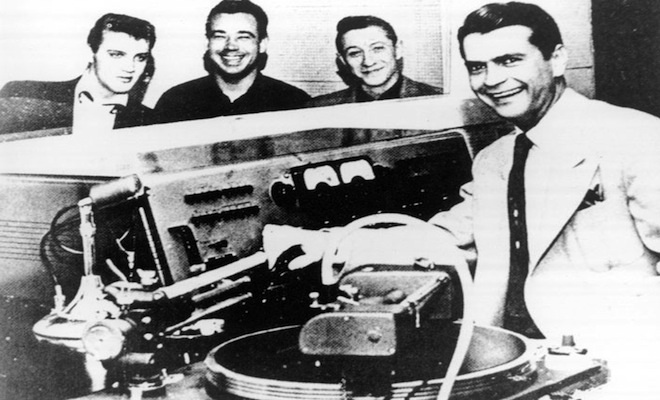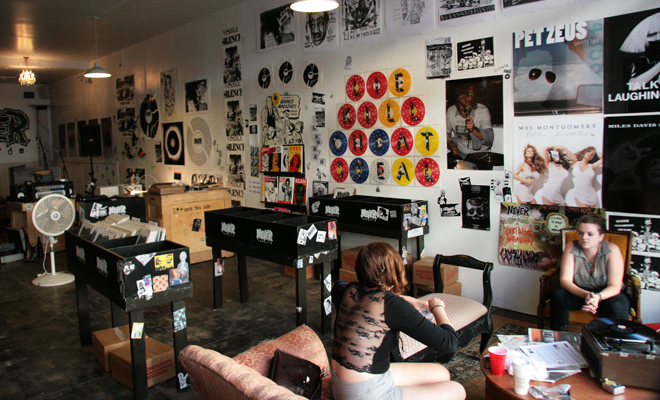Never Records New Orleans

Records on display and available for listening at Never Records New Orleans.
When I was a teenager, “seeing the world” was an excuse for going to record stores. My first unsupervised urban experiences were unsanctioned drives from Poland Spring, Maine to a few Boston shops I chose from a diner’s phone book. As a high-school junior, I visited a college campus 800 miles from home because I heard they had a great record store. They did, and I graduated four years later. While attending said college, I studied abroad in London. Guess why.
Behavior like this is ultimately not that unique, and record-store geekdom has become something of a trope, albeit a fading one as music marches inexorably toward intangibility. Staying up late with friends and listening to digital files not only drains the romance from the social listening experience, it just doesn’t sound as good as listening to records. Challenging some of these structural issues with the contemporary moment in music is one part of artist Ted Riederer’s mission with Never Records, a recurring project he has called a “record store within an art exhibition within a retail space” and a “love letter” to record stores. This New Orleans manifestation is Never Records’ fifth, the second time the project has appeared in the US. New Orleans has several excellent record storesâ¯most notably Domino Sound and Euclid Records; Never Records is not their competition. Really, it isn’t a record shop at all, more a simulacrum of one.
To wit: a promotional poster for Mariah Carey’s 2009 record Memoirs of an Imperfect Angel hanging on the wall initially seems to be just that…except the text reads WES MONTGOMERY: FULL HOUSE, the seminal jazz guitarist’s 1962 album. And while there are dozens of records in bins, one cluster of them is actually a poem composed by Riederer from the text allowed to show through mostly blacked-out album covers; many of the rest are records cut by New Orleans musicians (and non-musicians) on site. That’s where they’ll remain until Riederer packs up the installation in early Novemberâ¯none of the records filling his bins are to be sold.
Another mission of Riederer’s project is to encourage social interaction within the temporary warehouse space Never Records will inhabit until November 4. Relational work like this always stands on tricky terrain, especially in a city famous for its social agility. At its worst, the practice of constructing social situations as art can come off as paternalistic or elitist, especially when a visiting artist overlooks or undermines the contexts that define a locality’s sense of specificity. To this end, the centerpiece of the space is a performance area, abutted by Riederer’s makeshift recording studio. After booking a slot, Riederer works with a local band or individual to record a track directly onto one side of a 12” record. These are then packaged into record jackets hand-screened by Riederer, which the band then embellishes by hand. Like the records cut when Never Records was in London, Liverpool, or Derry, the New Orleans ones will be available for listening wherever the project appears again. If the interactive quotient of relational art is usually contingent on participants informing or influencing an artist’s basic structure, in this case Riederer fully relents the author role, enabling people to transcend a secondary role as participant and become the artist themselves. Riederer, the laborer-producer, in effect becomes an assistant; the codes premeditating art experience are flipped. The gift-economy aspect of Never Records isn’t denoted just by time; the artist also receives one of the two handsome clear vinyl 12”s Riederer cuts from a three-hour session.
While visiting the space on a few different occasions, I observed Riederer working on a rollicking Cajun number, and then a beautifully psychedelic track built around a moody loop. On a turntable in the lounge area, I listened to spacey experimental music (Rob Cambre); a pleasantly fuzzed-out song about chasing a girl across the country (Terrible Summer); the “pure evil sounds of skateboarding” (SF & CW, skaters who stumbled upon the space late at night and whose recording session ended when one fell into the microphone); and a laconic oral history of the St. Claude collective The Front spoken by some of its members. On a blog, Riederer has posted audio from several sessions, like bounce superstar Katey Red’s almost a capella rap and Dummy Dumpster’s impressively weird spazz-rock.
In discussing Never Records, Riederer has spoken about the diminishment of “real community” in music. With its tightly-knit bounce, jazz, rap, and rock scenes, New Orleans wouldn’t seem to suffer from that problem in abundance, but I think I understand his point. The digital revolution is not all bad: music has become much cheaper to record and is more accessible than ever. But it has also changed the acts of listening and recording from their once-inherent collaborative, social nature. At its root, Never Records is cartographic in scope: it is Riederer’s ticket to see and hear the world, building his own sonic archive and allowing cities to speak for themselves.

Installation view of Ted Riederer's Never Records New Orleans.
Editor's Note
Never Records’ closing party is Saturday, November 3, 6 pm, at 841 Carondolet Street. Several bands will play, selected by former Prospect curator Dan Cameron.



